Related Research Articles
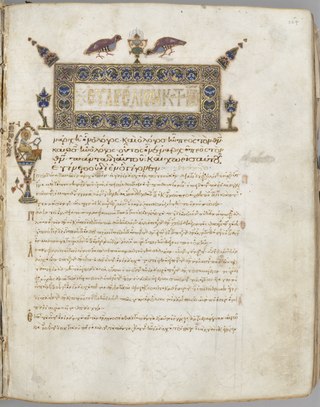
An illuminated manuscript is a formally prepared document where the text is often supplemented with flourishes such as borders and miniature illustrations. Often used in the Roman Catholic Church for prayers, liturgical services and psalms, the practice continued into secular texts from the 13th century onward and typically include proclamations, enrolled bills, laws, charters, inventories and deeds.
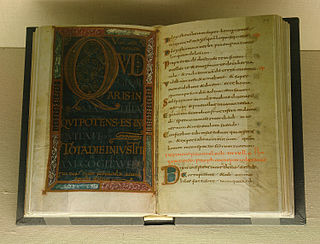
A psalter is a volume containing the Book of Psalms, often with other devotional material bound in as well, such as a liturgical calendar and litany of the Saints. Until the emergence of the book of hours in the Late Middle Ages, psalters were the books most widely owned by wealthy lay persons. They were commonly used for learning to read. Many Psalters were richly illuminated, and they include some of the most spectacular surviving examples of medieval book art.

The Melisende Psalter is an illuminated manuscript commissioned around 1135 in the crusader Kingdom of Jerusalem, probably by Fulk, King of Jerusalem for his wife Queen Melisende. It is a notable example of Crusader art, which resulted from a merging of the artistic styles of Roman Catholic Europe, the Eastern Orthodox Byzantine Empire and the art of the Armenian illuminated manuscript.

The Vergilius Augusteus is a manuscript from late antiquity, containing the works of the Roman author Virgil, written probably around the 4th century. There are two other collections of Virgil manuscripts, the Vergilius Vaticanus and the Vergilius Romanus. They are early examples of illuminated manuscripts; the Augusteus is not illuminated but has decorated initial letters at the top of each page. These letters do not mark divisions of the text, but rather are used at the beginning of whatever line happened to fall at the top of the page. These decorated initials are the earliest surviving such initials.

The Morgan Beatus is an illuminated manuscript with miniatures by the artist Magius of the Commentary on the Book of the Apocalypse by the eighth-century Spanish monk Beatus, which described the end of days and the Last Judgment. Having been created at some time in the 10th century, the Morgan Beatus is one of the oldest examples of a revived Spanish apocalypse tradition. According to the style it was created by Mozarabs. The Apocalypse and the commentary on this scripture by Saint Beatus of Liébana became one of the most important religious texts of the Middle Ages, and was often illustrated very fully.

The Paris Psalter is a Byzantine illuminated manuscript, 38 x 26.5 cm in size, containing 449 folios and 14 full-page miniatures. The Paris Psalter is considered a key monument of the so-called Macedonian Renaissance, a 10th-century renewal of interest in classical art closely identified with the emperor Constantine VII Porphyrogenitus (909-959) and his immediate successors.
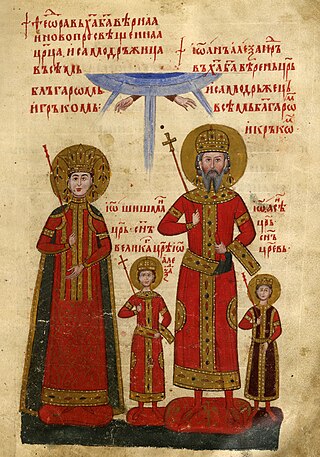
The Gospels of Tsar Ivan Alexander, Tetraevangelia of Ivan Alexander, or Four Gospels of Ivan Alexander is an illuminated manuscript Gospel Book, written and illustrated in 1355–1356 for Tsar Ivan Alexander of the Second Bulgarian Empire. The manuscript is regarded as one of the most important manuscripts of medieval Bulgarian culture, and has been described as "the most celebrated work of art produced in Bulgaria before it fell to the Turks in 1393".
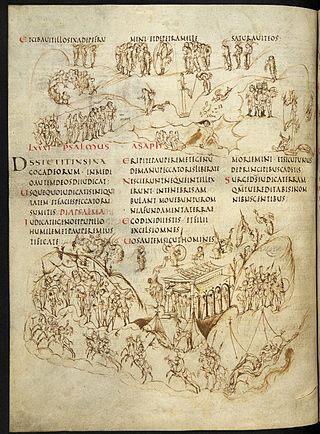
The Utrecht Psalter is a ninth-century illuminated psalter which is a key masterpiece of Carolingian art; it is probably the most valuable manuscript in the Netherlands. It is famous for its 166 lively pen illustrations, with one accompanying each psalm and the other texts in the manuscript. The precise purpose of these illustrations, and the extent of their dependence on earlier models, have been matters of art-historical controversy. The psalter spent the period between about 1000 to 1640 in England, where it had a profound influence on Anglo-Saxon art, giving rise to what is known as the "Utrecht style". It was copied at least three times in the Middle Ages. A complete facsimile edition of the psalter was made in 1875, and another in 1984 (Graz).
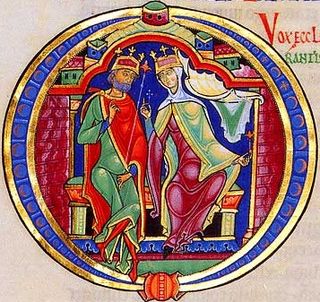
The Winchester Bible is a Romanesque illuminated manuscript produced in Winchester between 1150 and 1175 for Winchester Cathedral. With folios measuring 583 x 396 mm., it is the largest surviving 12th-century English Bible. The bible belongs to a group of large-sized bibles that were made for religious houses all over England and the continent during the 12th century. The Winchester Bible is important to understanding the history of medieval art, because it was left only partially completed, giving insight into the creation and production of these kinds of Bibles. It can still be seen in the Winchester Cathedral Library, which has been its home for more than eight hundred years. Before it was returned to Winchester Cathedral, the Bible had many owners and suffered because of it. Pages have been removed and torn out; one of those pages is known as the Morgan Leaf and is now owned by the Morgan Library in New York.
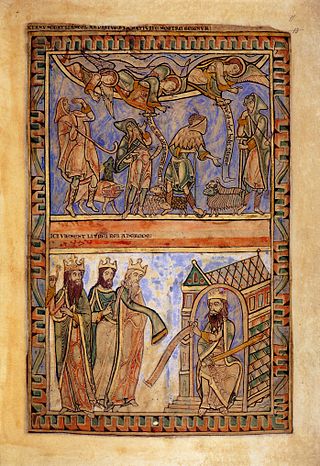
The Winchester Psalter is an English 12th-century illuminated manuscript psalter, also sometimes known as the Psalter of Henry of Blois, and formerly known as the St Swithun's Psalter. It was probably made for use in Winchester, most scholars agreeing that the most likely patron was the Henry of Blois, brother of Stephen, King of England, and Bishop of Winchester from 1129 until his death in 1171. Until recent decades it was "a little-studied masterpiece of English Romanesque painting", but it has been the subject of several recent studies.

Two lavishly illustrated illuminated manuscript psalters are known as the Psalter of Saint Louis as they belonged to the canonized King Louis IX of France. They are now in Paris and Leiden, and are respectively good examples of French Gothic and English Romanesque illumination.

There are fourteen known Byzantine manuscripts of the Book of Job dating from the 9th to 14th centuries, as well as a post-Byzantine codex illuminated with cycle of miniatures. The quantity of Job illustrations survived in the fifteen manuscripts exceeds 1800 pictures. The total is aggregated considerably by single images of Job in other manuscripts, frescoes and carvings.

The Kupferstichkabinett, or Museum of Prints and Drawings, is a prints museum in Berlin, Germany. It is part of the Berlin State Museums, and is located in the Kulturforum on Potsdamer Platz. It is the largest museum of graphic art in Germany, with more than 500,000 prints and around 110,000 individual works on paper.

The Howard Psalter and Hours is a 14th-century illuminated prayerbook. It includes a liturgical Psalter with canticles and litany, the Office of the Dead, a calendar of East Anglian origin and an incomplete Hours of the Passion. It was produced between 1310 and 1320. It is written in Latin in a Gothic script in two columns per page. There are 115 extant folios which measure 360 by 235 mm. The text block occupies an area of 250 by 166 mm. It is bound together with the De Lisle Psalter, a contemporary psalter.

The Gorleston Psalter is a 14th-century manuscript notable for containing early music instruction and for its humorous marginalia. It is named for the town of Gorleston in Norfolk.
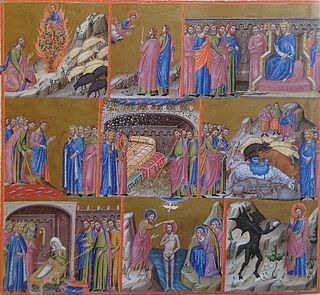
The Great Canterbury Psalter is an early 13th- and mid 14th-century illuminated manuscript with the shelfmark MS lat. 8846 in the Bibliothèque nationale de France in Paris. It was made in two different locations and moments in time: at Canterbury around 1200 and in Catalonia around 1340. It is the last of a series of copies of the Utrecht Psalter made in Canterbury, following the Harley Psalter and the Eadwine Psalter.
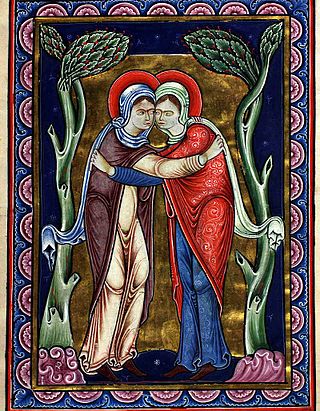
TheCopenhagen Psalter is a 12th-century illuminated manuscript psalter, made in England. It may have been created for the education of the boy king, King Canute VI of Denmark. This manuscript is known for the many artists who contributed to the full-page illuminations. The Copenhagen Psalter is currently in Denmark.
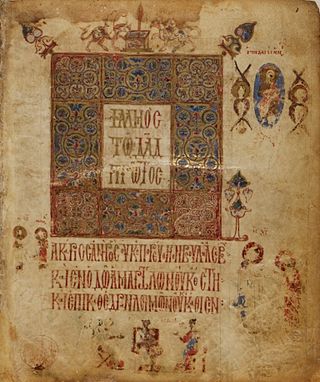
The Theodore Psalter is an illustrated manuscript and compilation of the Psalms and the canticles, or Odes from the Old Testament. "This Psalter has been held in the British Library since 1853 as Additional 19.352," wrote Princeton Art History professor Charles Barber in his first essay that is a companion to the Theodore Psalter E-Facsimile. Barber called the Psalter, "One of the richest illuminated manuscripts to survive from Byzantium."
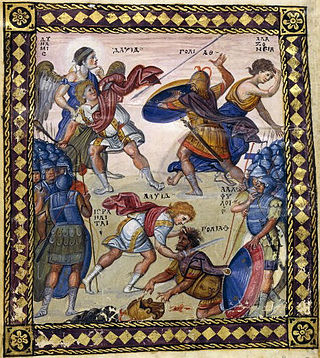
Byzantine illuminated manuscripts were produced across the Byzantine Empire, some in monasteries but others in imperial or commercial workshops. Religious images or icons were made in Byzantine art in many different media: mosaics, paintings, small statues and illuminated manuscripts. Monasteries produced many of the illuminated manuscripts devoted to religious works using the illustrations to highlight specific parts of text, a saints' martyrdom for example, while others were used for devotional purposes similar to icons. These religious manuscripts were most commissioned by patrons and were used for private worship but also gifted to churches to be used in services.

The Abbey Bible is a complex illuminated manuscript, created in Bologna, Italy in the mid-thirteenth century. It is an example of a Gothic-style Bible, with significant Byzantine influence. This manuscript is especially known for its distinctive marginal imagery. The Abbey Bible now resides at the J. Paul Getty Museum in Los Angeles, CA.
References
- 1 2 3 4 5 Iohannis, Spatharakis (1976). The Portrait in Byzantine Illuminated Manuscripts. Netherlands Organization for the Advancement of Pure Research. ISBN 9004047832.
- 1 2 3 4 Havice, Christine (1984). "The Marginal Miniatures in the Hamilton Psalter (Kupferstichkabinett 78.A.9.)". Jahrbuch der Berliner Museen: 79–142. doi:10.2307/4125803. JSTOR 4125803.
- 1 2 Cormack, Robin (2000). Byzantine Art . Oxford University Press. pp. 199–200. ISBN 978-0-19-284211-4.